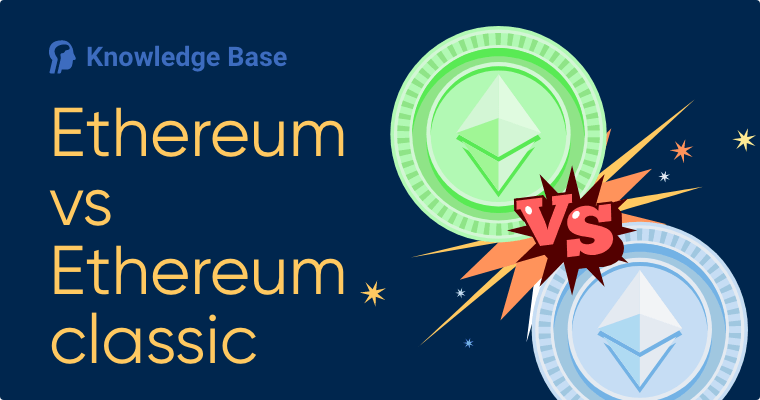Ethereum vs. Ethereum Classic: Ideologies Clash
Ethereum has been in the spotlight among cryptocurrency enthusiasts for some time now. It sits comfortably below Bitcoin as the cryptocurrency with the second-highest market cap. Many crypto investors believe that the Ethereum technology has excellent potential for building Web 3.0, or at least, greater value than it currently holds. However, you might have heard of another cryptocurrency with a similar name, Ethereum Classic, that isn’t as prominently featured as Ethereum.
Before we make an apple-to-apple comparison – Ethereum vs. Ethereum Classic – we’ll cover several related points: how the two cryptocurrencies are different from Bitcoin, how Ethereum came to be, and why they split.
Ethereum and Smart Contracts
The crucial distinction between the two Ethereums and cryptocurrencies like Bitcoin is the capability of creating smart contracts.
In layman’s terms, a smart contract is a program that outlines the agreed conditions between two parties. It acts as an impartial third party that ensures the contract is executed if the conditions are met.
This technology opens up plenty of opportunities that just aren’t possible with Bitcoin. Forbes’s annual Blockchain 50, the list of companies that employ blockchain, includes 24 organizations that use Ethereum and favorably reflect on the technology under its hood.
Ethereum’s History: From Inception to the DAO Hard Fork
The Ethereum network started in 2013 as the brainchild of Vitaly Dmitrievich “Vitalik” Buterin, the creator of Ethereum’s white paper and one of the co-founders of Ethereum. Unlike Satoshi Nakamoto, whose identity remains unknown, he is a real public face behind Ethereum.
Buterin’s idea was to implement a new programming language on Bitcoin’s blockchain. Any applications developed and used on the blockchain could automate or execute more complicated tasks. However, his suggestion wasn’t accepted by the Bitcoin community.
After a public funding campaign in July 2014 that raised around 25,000 BTC, Vitalik and his team started working on Ethereum.
Ethereum and Ethereum Classic split as a result of the DAO Hard Fork in July 2016.
The DAO, or Decentralized Autonomous Organization, was conceptualized as the central point for entrepreneurs and investors to support and invest in DApps – decentralized applications. DAO would work similarly to Kickstarter, where projects that gain the support of more than 20% of the community would get funding. The DAO collected more than $150 million in funding, entering history as one of the most successful funding campaigns. Anyone could use Ether to support a project of their choosing. The DAO implemented the option to withdraw your Ether if you changed your mind about supporting a project.
It was a programming error that led to the ETH vs. ETC split in the Ethereum community. The error led to a recursive call when users returned DAO tokens in exchange for Ether where the transaction didn’t register on the public ledger. This effectively meant that users could return DAO tokens multiple times until they drained the DAO Ether funds. The result? A $50 million loss out of a $150 million investment. The only reason why perpetrators didn’t cash out the drained Ether was that they couldn’t use it 28 days after refunding. That’s how the funds were recovered.
Even though the error was in the DAO programming, this event significantly impacted Ethereum’s reputation. After consulting with the Ethereum community and voting on what action to take, Ethereum performed a hard fork. Essentially, developers split a single blockchain in two.
Ethereum Classic vs. Ethereum Hard Fork Debate
The blockchain wasn’t the only thing split at the time. The ideological divide became apparent as well. A part of the community was against reverting the DAO hack, while the majority favored creating a fork and reversing the illegitimate transactions.
The reason for not interfering with the blockchain is, in fact, a moral turning point. The notion that “the code is law” is a premise the Ethereum Classic community often emphasizes. The idea behind the blockchain was to create an immutable system that won’t be affected by the actions of any group or individual. Therefore Ethereum Classic’s fork of the blockchain still holds the record of the transactions made in the DAO exploit.
The hard fork option meant that the Ethereum fork left the block without the DAO attack transaction in its blockchain, while Ethereum Classic continued with it. Ethereum developers accomplished it by creating a branch that would work in parallel with the original block.
The hard fork restored investors’ confidence, and Ethereum’s development continued with the Enterprise Ethereum Alliance’s support. Vitalik Buterin also supported the hard fork, and as the Etherum community holds him in high regard, his opinion mattered.
What Is Ethereum Classic, and How Is It Different From Ethereum?
Since its creation in 2016, Ethereum Classic has taken a different development road from Ethereum.
Consensus Mechanism
The Ethereum development team has already implemented significant changes in how the Ethereum network operates. The transactions are at the moment validated by Proof of Work (PoW), which requires a considerable amount of computer power. The network is currently in a transitional period, as it’ll soon be upgraded to use Proof of Stake (PoS) for validation – a process that consumes far less power. Unlike PoW, the PoS consensus mechanism requires validators to “stake” Ether to be eligible to validate new blocks.
There lies the difference between Ethereum and Ethereum Classic. Ethereum Classic doesn’t have plans to move away from the Proof of Work consensus mechanism.
Circulating Supply
Cryptocurrency investors may find it interesting that, at the moment, Ethereum doesn’t have a limited capacity like Bitcoin. The only fixed cap is 18 million ETH per year. Ethereum Classic made the change from an unlimited supply to a 210.7 million ETC cap.
Ethereum’s supply cap, however, is not set in stone. If the community adopts the Ethereum Improvement Proposal 960 (EIP 960), limiting the supply cap of Ethereum may lead to a price boost similar to Bitcoin’s.
Ethereum vs. Ethereum Classic: ICOs
Ethereum holds firm as the primary platform for Initial Coin Offerings (ICOs). It holds more than 85% of the ICO market with more than 4,500 projects. It’s considered a go-to platform for fundraising because of the ERC-20 tokens, which are basically blockchain-based assets. Ethereum Classic remains a far less popular platform for raising funds for upcoming projects.
Market Cap
The value of both cryptocurrencies is in constant flux. The crypto market is volatile, but some say it’s undervalued and is only expected to continue rising.
Whatever the case, the Ethereum Classic vs. Ethereum price comparison clearly shows that the latter takes the prize. At the time of writing this article, Ethereum had a much more significant year-on-year price rise than Ethereum Classic. From April 2020 to April 2021, Ethereum’s price jumped from about $170 to an all-time high of approximately $2,150. Within the same period, Ethereum Classic rose from $6 to $18.
Ether is currently the only cryptocurrency coming close to Bitcoin. Its market cap now sits at $245 billion, while Ethereum Classic is presently stable at $2.1 billion.
What the Future Holds for Ethereum vs. Ethereum Classic
While the future is uncertain for any cryptocurrency, it looks much more stable for Ethereum than Ethereum Classic. With the Enterprise Ethereum Alliance confident about the project and including notable names such as JPMorgan Chase & Co., Microsoft, and Intel, Ethereum technology adoption is moving toward the mainstream.
In August 2020, Ethereum Classic had to fend off a third 51% attack. The attacks have caused drastic responses from crypto exchanges, with Coinbase setting withdrawal time to two weeks and OKEx halting any ETC deposits and withdrawals. Radical measures are needed for the ETC cryptocurrency to ensure general adoption and gain investors’ confidence. Developers have already released a set of security updates to prevent new 51% attacks. Still, it remains to be seen what these two promising technologies will achieve in the future.
FAQ
Does Ethereum Classic have a future?
Ethereum Classic’s future largely depends on future updates made to its platform. It’s based on the same technology as Ethereum. However, Ethereum took a different development path after the DAO Hack and had a better overall trajectory than Ethereum Classic.
What is the point of the Ethereum Classic?
The ETC vs. ETH debate usually leads to questions like this. Both platforms’ goal is to provide an open-source blockchain-based distribution system with smart-contract functionality. While Ethereum has proved more successful, Ethereum Classic could provide a platform with smaller gas fees while we wait for Ethereum to launch the EIP 1559 overhaul of its network.
Is Ethereum Classic worth mining?
Mining profitability always depends on the current popularity of a cryptocurrency, mining difficulty, and electricity price. Until Ethereum completes its transition to PoS, it will remain the most profitable cryptocurrency for mining with GPUs.
Is Ethereum Classic part of Ethereum?
Ethereum Classic is a separate fork of Ethereum, and it functions as an independent cryptocurrency. For more details about the split and what brought it about, read our “Ethereum vs. Ethereum Classic: Ideologies Clash” article.






